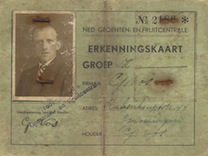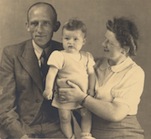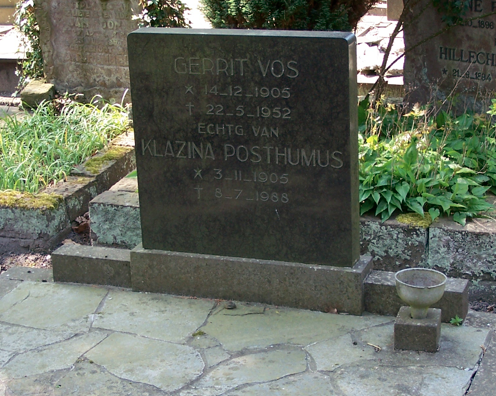Gerrit Vos was the son of a seed grower in Groningen
and a farmers daughter.
His father's gardens were on Groningen's south side,
west of the "Hereweg", south of the Rabenhauptstraat.
They extended from the "Menneslaan"
(a dead end alley now replaced by the broad Vechtstraat)
to beyond the "Zuider Begraafplaats" (southern cemetary).
How these gardens were organised and what the lay-out was can be found in
"De Tuinen",
the memories of Jakob Vos, son of Gerrit's brother Jan-Roelf
who later would continue the gardens.

|

|
After high school he continued to work with his father.
An "official portrait" was made at age of about 19.
Initially, Gerrit was mostly in the gardens.
But he also manned the market stall.
For that he needed an official licence;
this "Erkenningskaart" (it is undated)
is likely from about 1935.
The document shows the address his parents had retired to.
Around that time father Jakob had passed the
seed-growing enterprise on to his second son Jan-Roelf.
Gerrit's work was also to bring products to the "Bodenterrein"
(the transporters hub),
where lorries would wait to bring packages to destinations in Groningen province.
Gerrit enjoyed life, he was sociable, had lots of friends
and regularly spent his pasttime going out.
It was said he knew everybody in town.
Gerrit's looks had a special feature: his left ear stood further out
than the other one (see photo on the identity card).
This trait ran in the Vos family, foremost with the males.
Klazina (Sien) Posthumus was the daughter of Klaas Posthumus, farmer and merchant, and Liena Hofstede, a farmers daugther. Sien was born in a small farm house, at the edge of the heath, west of Marum, where Klaas made his living in part by cultivating parcels of heath. Not long thereafter her father had been able to buy the village pub and guesthouse, in Marum-West. The family would ultimately count 10 children, 7 girls and 3 boys.
Sien, as all children, went to elementary school in Marum. In winter one would wear darker clothes, in summer the girls would often go in white dresses. The school was close by, in the same street towards the church. To the side of the church, Sien's parents owned a meadow, with a mound having a tree on top.
Sien then went, the only one of the children, to high school,
the "MULO";
the other girls went to "huishoudschool",
the school of domestic economy.
Sien had done well in elementary school,
had been good in all subjects, also in arithmetic.
She had learned german there and could read and write the old german print.
RHV: my mother recounted...
In the last weeks of the last class of the MULO
I had to help harvest potatoes on my fathers land.
In those days it was normal for children to stay out of school for that.
I had been quite dilligent in school and after harvest time I
was afraid to go back to school out for fear of
now getting low grades and not being able to pass the final exam.
The headmaster then came to my parents to convince them that I would
be all right.
But they let it be, so I did not finish high school.
Sien then wanted to become a nurse. One had to provide for a uniform oneself but Sien did not have the money. She could have asked her oldest brother Freerk, who ran a successful shop in household wares in Marum Westy, for a loan but Sien shied away from that.
In 1923/24 the family moved to Groningen, to Prinsesseweg 59. Father Klaas had sold the business in Marum and started in an existing pub in Groningen, in the Gelkingestraat. The daughters had to work shifts there.

|
Sien had found a job as sales person with
"Meijers koek" (Meijers pastry) at the Grote Markt.
Soon she also did some of the administration.
Thus she never came to be a nurse.
She stayed at Meijers Koek until she married.
The photo shown was taken in about 1929.
In the early 1930's her parents gave up the boarding house,
they both had health problems.
The family now moved to the W.A. Scholtensstraat.
When young people went out at night, one option was to go to "Huize Maas" at the Vismarkt, where one could dance. On some night Sien and Gerrit met there. On 05-04-1931 (date in their rings) they officially engaged and then started to save (in the 1930s, years of the economic crisis), Sien for the trousseau, Gerrit for investment.
As of 1937, the economy seemed to veer back. Early in 1937, a specialty grocery shop was offered for rent at the Damsterdiep (the previous operator had been declared bankrupt, a fate many more had suffered). Gerrit and Sien now took their courage to start their own grocery.
Gerrit and Sien married in 1937.

|
With a shop at the Damsterdiep including living quarters,
there was no reason to postpone marriage.
The announcement gives the address Damsterdiep 16
(see the photos and clippings).
Soon they asked in an advertisement for help in the shop.
They also sold vegetables from the gardens at the Menneslaan,
but slowly made the business into a grocery shop in the upper end,
with specialties and, as one called it, "commestibles"
(as the previous shop owner had done).
Gerrit could borrow money from his father and other relatives
and on 23-02-1939 he could buy the entire house with shop.
The shop had two shopwindos with the door in between. The shop had a larger depth than width. In the rear of the shop was a sliding door giving to the living room, having two windows, high in a wall over the alley of the neighbours on the city side. At right was a corridor with, just past the living room, a staircase to the attic, on which was a room for (later) daughter Lineke. Then came the bedroom with walk-in closet under the stairs. The corridor turned at its end into the kitchen.

|
Above the shop was a separate living unit with its own front door and stairs, at left in the shop front. One could also get to its stair directly from the shop. That dwelling had a room at the street, a very small room above the stairs, and in the rear a room and a kitchen. The top floor had a room with low windows and above it was the attic.
They did the shop together: Gerrit mostly delivered the orders, Sien did the shop and bookkeeping.

|
RHV: When my father and mother started the business, the seperate living unit above the shop was used by the still unmarried children of Opa and Oma Posthumus, aunt Dien and uncle Klaas. Aunt Wieb ran the household of Gerrit and Sien. Occasionally, other members of the larger family, who temporarily had no place to stay, would live at Damsterdiep 16; I remember aunt Hens, who used an attic room of the dwelling behind the shop.
In 1940, Sien became pregnant.
The boy, Jakob Klaas Vos,
was born with congenital deformations and did not live long.
In 1942, Rolina Hendrika (Lineke) was born.
War time 1940-1945
In the course of the war food supplies got low. Essential commodities were rationed and distributed based on coupons, "op de bon" (see box).

|
Egbert Nicolaas and family had moved from Zwolle to Veendam. That family now lived again closer to Groningen. Aunt Jo lived in Assen, in the service of Mr Was. He had a large garden. In 1943 the family visited aunt Jo (see photo), aunt Wieb, Sien and Gerrit with little Lineke, and Renske and Egbert Nicolaas with son Joop (for the latter three see the complete photo).

|
Some time near the end of the war, Gerrit was arrested. He was interrogated at the notorious "Scholtenshuis". He must have been suspected of fraud with food coupons. RHV: I do not know what happened exactly. But he was in jail for a while, at the Hereweg. And then one was a hero! In March 1945 he got a document stating he was "untauglich" (unfit) for further service at the defense works. It is unclear how he got this document. It surely has meant that, in the last weeks of the war, he would not be forced into labour for the occupiers.
When the Canadian troops of the allied forces approached, everybody was downstairs, in the room behind the shop. Aunt Hens was nosy and, in spite of warnings, went to look out of the shop window. There was shooting on the Damsterdiep and she saw how, on the other side, a young man was shot.





